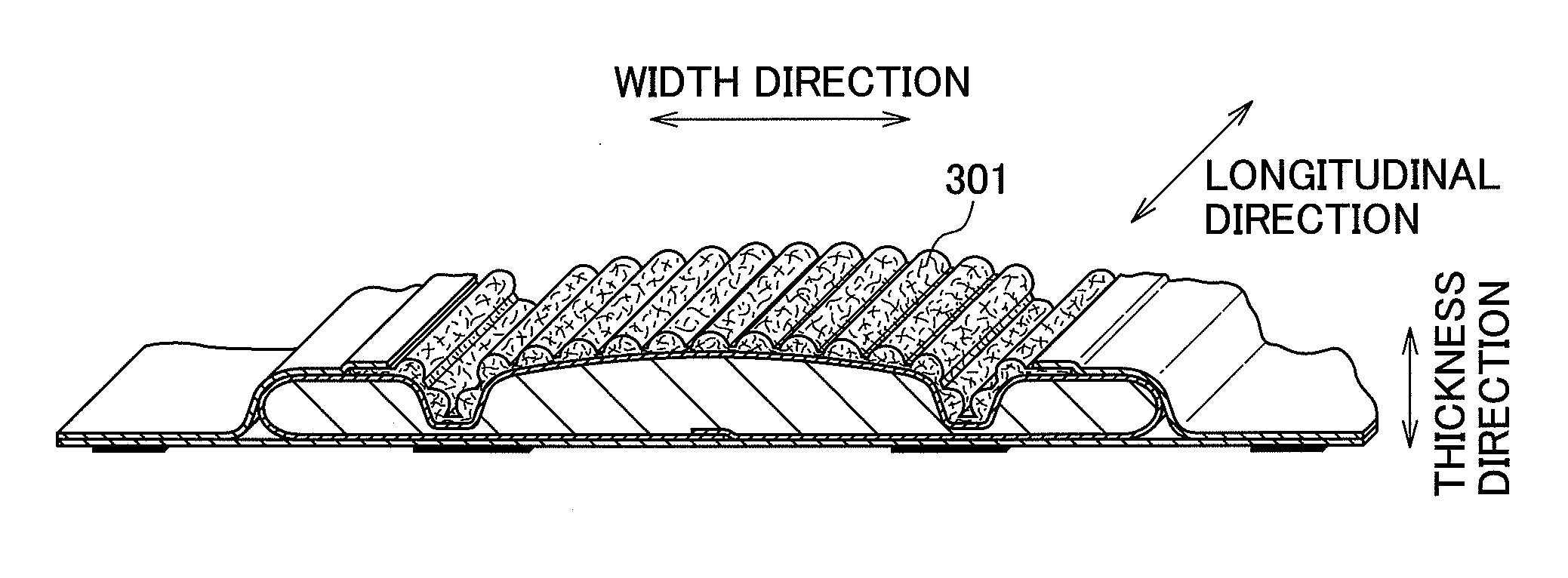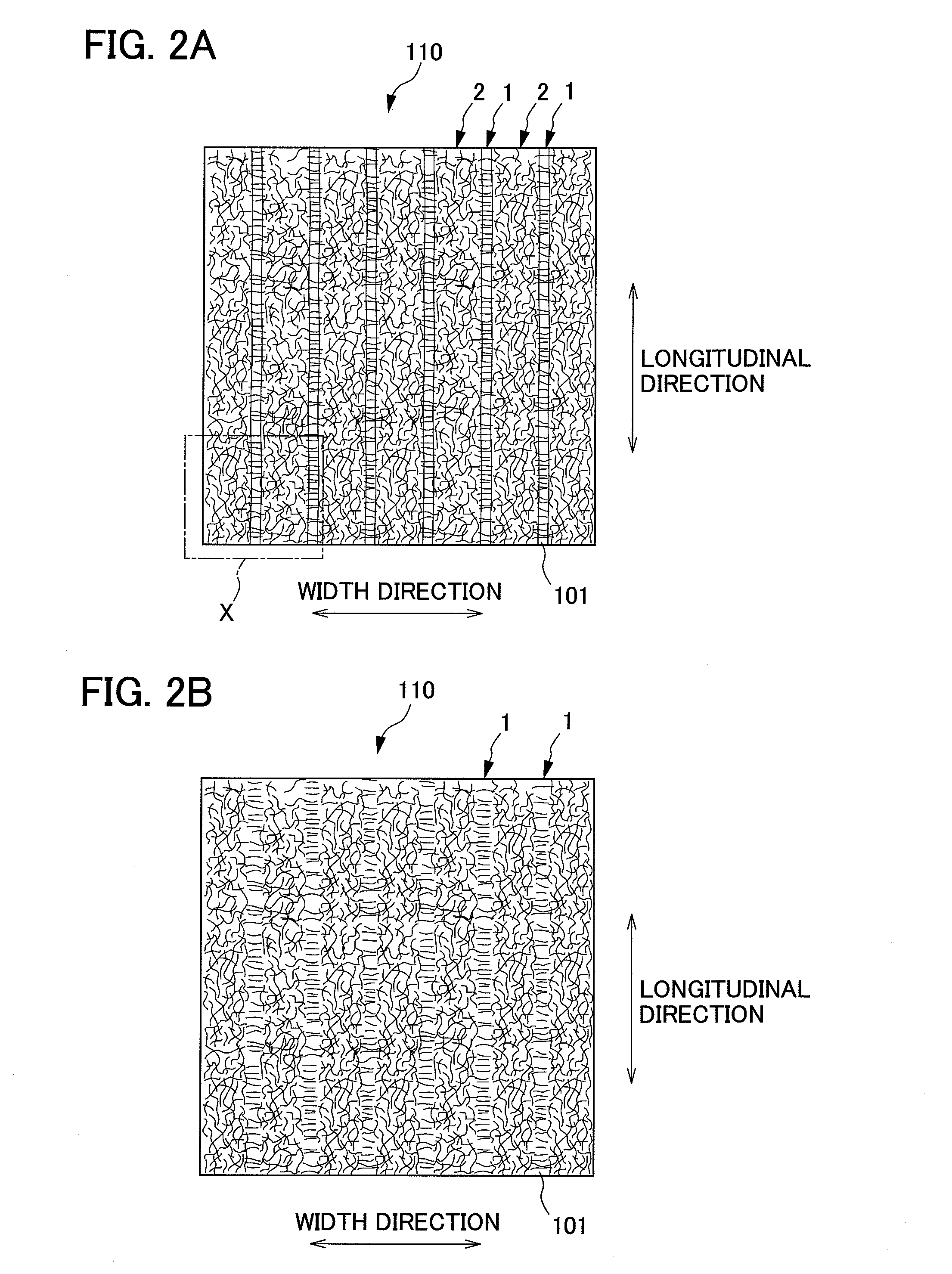Nonwoven fabric
- Summary
- Abstract
- Description
- Claims
- Application Information
AI Technical Summary
Benefits of technology
Problems solved by technology
Method used
Image
Examples
first embodiment
1. FIRST EMBODIMENT OF THE NONWOVEN FABRIC
[0058]FIGS. 2A to 5 explain the first embodiment of the nonwoven fabric of the present invention.
1-1. Shapes
[0059]As shown in FIGS. 2A, B and FIG. 3, a plurality of groove portions 1 is formed in parallel at substantially equidistant spacing along a first direction (hereinafter referred to as a longitudinal direction) on a first side of the nonwoven fabric 110 according to this embodiment. In this embodiment, the plurality of groove portions 1 is formed in parallel at equidistance spacing, but this is not meant to be a limitation. The spacing between adjacent groove portions 1 can be different. It is also acceptable that the spacing of the groove portions 1 is not parallel, but varied.
[0060]Furthermore, raised ridge portions 2 are formed between two adjacent groove portions 1 and 1. A plurality of raised ridge portions 2 and 2 are formed in parallel at equidistant spacing, in the same way as the groove portions 1. The heights (the thickness ...
second embodiment
2-1. Second Embodiment
[0113]FIGS. 10 and 11 explain the second embodiment of the nonwoven fabric of the present invention.
2-1-1. Nonwoven Fabric
[0114]As shown in FIGS. 10 and 11, the nonwoven fabric 116 of the second embodiment are different from the first embodiment in the point that the overall nonwoven fabric 116 are rolling in a wave shape. The following will now explain the points that are different to the first embodiment.
[0115]The nonwoven fabric 116 of the second embodiment has rolling wave-shapes substantially perpendicular to the direction that the groove portions 1 and raised ridge portions extend.
2-1-2. Manufacturing Method
[0116]The method for manufacturing the nonwoven fabric 116 of the second embodiment is the same as the method used for the first embodiment, but the configuration of a mesh supporting member 260 that is the air-permeable support member is different. The mesh supporting member 260 of the second embodiment is formed by weaving a plurality of wires 261 of...
third embodiment
2-2. Third Embodiment
[0123]FIG. 12 explains the third embodiment of the nonwoven fabric of the present invention.
[0124]As shown in FIG. 12, the shapes of the surfaces opposite to the surfaces formed with the raised ridge portions 2 of the nonwoven fabric 140 are different from those of the first embodiment. The following will now explain the points that are different to the first embodiment.
2-2-1. Nonwoven Fabric
[0125]The groove portions 1 and raised ridge portions 2 are alternately formed in parallel on the first surface side of the nonwoven fabric 140 of the third embodiment. Also, the area of the bottom surface of the raised ridge portions 2 is formed to project to the side that the raised ridge portions 2 projects, on the second surface side of the nonwoven fabric 140. Said another way, the areas of the bottom surfaces on the second side of the raised ridge portions 2 of the nonwoven fabric 140 form indented concave portions. Also, the areas of the second side at the bottom surf...
PUM
 Login to View More
Login to View More Abstract
Description
Claims
Application Information
 Login to View More
Login to View More - R&D
- Intellectual Property
- Life Sciences
- Materials
- Tech Scout
- Unparalleled Data Quality
- Higher Quality Content
- 60% Fewer Hallucinations
Browse by: Latest US Patents, China's latest patents, Technical Efficacy Thesaurus, Application Domain, Technology Topic, Popular Technical Reports.
© 2025 PatSnap. All rights reserved.Legal|Privacy policy|Modern Slavery Act Transparency Statement|Sitemap|About US| Contact US: help@patsnap.com



